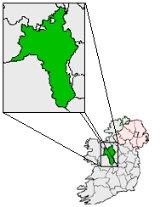
Fuerty
Encyclopedia
Fuerty is a hamlet on the R366
regional road near the town of Roscommon
in County Roscommon
, Ireland
. The place is known for a ruined church and ancient graveyard on the site of a Celtic Christian abbey.
visited Fuerty and left a deacon to found a monastic settlement here. The deacon, Justus, baptised Saint Ciarán
, a local man, around the year 500. Ciaran went on to found Clonmacnoise
, which became one of the most important monasteries and centres of learning in Europe.
Two 8th century granite grave slabs in the west side of the tower bear inscriptions that can still be read. One of them bears the name of Ardeachan, Abbot of Clonmacnoise. The abbey was attacked and destroyed by the English Elizabethan invaders and all its monks were slain. The existing ruins are of a 17th century Church of Ireland. The tower was added in 1790 but the church was destroyed by fire in 1870.
R366 road
The R366 road is a regional road in Ireland linking R362 regional road to the N63 national secondary road in Roscommon Town. It passes through the hamlets of Castlecoote and Fuerty en route.The road is long and is located entirely in County Roscommon....
regional road near the town of Roscommon
Roscommon
Roscommon is the county town of County Roscommon in Ireland. Its population at the 2006 census stood at 5,017 . The town is located near the junctions of the N60, N61 and N63 roads.-History:...
in County Roscommon
County Roscommon
County Roscommon is a county in Ireland. It is located in the West Region and is also part of the province of Connacht. It is named after the town of Roscommon. Roscommon County Council is the local authority for the county...
, Ireland
Ireland
Ireland is an island to the northwest of continental Europe. It is the third-largest island in Europe and the twentieth-largest island on Earth...
. The place is known for a ruined church and ancient graveyard on the site of a Celtic Christian abbey.
The church and graveyard
It is said that Saint PatrickSaint Patrick
Saint Patrick was a Romano-Briton and Christian missionary, who is the most generally recognized patron saint of Ireland or the Apostle of Ireland, although Brigid of Kildare and Colmcille are also formally patron saints....
visited Fuerty and left a deacon to found a monastic settlement here. The deacon, Justus, baptised Saint Ciarán
Ciarán of Clonmacnoise
Saint Ciarán of Clonmacnoise was one of the early Irish monastic saints and Irish bishop. He is sometimes called Ciarán the Younger to distinguish him from Saint Ciarán of Saighir. He was one of the Twelve Apostles of Ireland....
, a local man, around the year 500. Ciaran went on to found Clonmacnoise
Clonmacnoise
The monastery of Clonmacnoise is situated in County Offaly, Ireland on the River Shannon south of Athlone....
, which became one of the most important monasteries and centres of learning in Europe.
Two 8th century granite grave slabs in the west side of the tower bear inscriptions that can still be read. One of them bears the name of Ardeachan, Abbot of Clonmacnoise. The abbey was attacked and destroyed by the English Elizabethan invaders and all its monks were slain. The existing ruins are of a 17th century Church of Ireland. The tower was added in 1790 but the church was destroyed by fire in 1870.
See also
- List of towns and villages in Ireland

